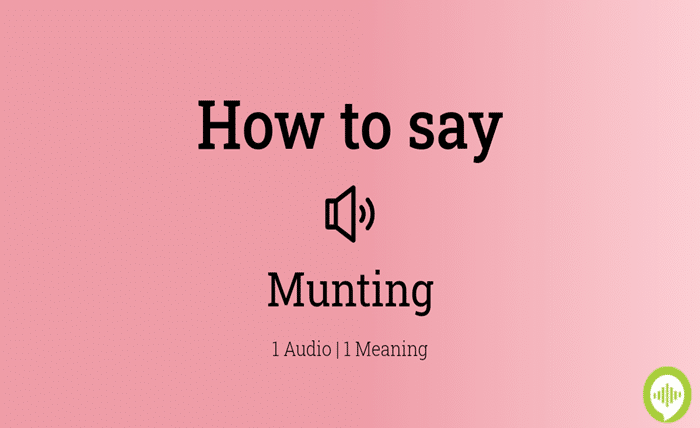Introduction
In the world of language and linguistics, there are often words and expressions that transcend their direct translations and carry cultural significance. One such term that has piqued curiosity among English speakers is “munting.” This word, though not commonly used in everyday English, has roots in different languages and cultures, and its meaning can vary depending on the context. Understanding the concept of “munting” in English opens the door to an appreciation of its subtlety, cultural relevance, and the layers it adds to language.
This blog post will delve into the meaning of “munting” in English, its origins, usage, and how it has evolved over time. We’ll explore its different connotations, from its informal use in certain regions to its more formal applications. We will also look into how the term has been embraced in online discussions and its place within the context of English lexicon.
What is “Munting” in English?
“Munting” is an informal term with various meanings depending on the region and context. In general, it can refer to something small, delicate, or miniaturized. The term is commonly used in certain dialects and regional English variations to describe something that is diminutive or compact. It is often used affectionately or to add a sense of charm to the description of an object, person, or action.
In many cases, “munting” is used in a playful context. For example, one might describe a small pet, a cute doll, or even a small gathering of people as “munting” to evoke a sense of endearment or lightheartedness. While this word is not widely known or used in formal English, it has found its place in specific social contexts where smaller, cuter, or more whimsical elements are being described.
The Origin of “Munting”
The origin of “munting” is largely attributed to regional dialects, particularly in the Philippines and parts of Southeast Asia. In Filipino, “munting” translates to “small” or “tiny,” often used as a way to describe something endearing or precious. The word carries a sentimental connotation, emphasizing the charm or appeal of smallness.
In English, “munting” is a borrowed term, adapted to describe the same qualities. Over time, it has found its way into informal English vocabulary, especially in communities with Filipino or Southeast Asian influences. This term is frequently used in literature, social media, and everyday conversations to convey a sense of cuteness, simplicity, or understated beauty.
How “Munting” is Used in Everyday English
In English conversations, “munting” can appear in a variety of contexts. It’s often used as an adjective to describe something small or charming. For example:
- “She gave me a munting gift for my birthday.”
- “The munting flowers in the garden made everything look so peaceful.”
- “They live in a munting house by the beach.”
In these examples, “munting” emphasizes the small, delicate, or charming nature of the objects being described. It’s important to note that while the word is more prevalent in informal English, it’s not widely recognized in formal dictionaries and may not be understood by all speakers. However, it’s gaining popularity through the spread of internet culture and regional dialect influences.
Munting in Popular Culture and Social Media
The rise of internet culture has played a significant role in the proliferation of words like “munting.” Social media platforms such as Instagram, Twitter, and TikTok have allowed terms from various languages and cultures to cross borders and find a new audience. “Munting” is one such term that has caught the attention of users, especially those interested in aesthetic posts or discussions about all things small, cute, and unique.
On Instagram, for instance, you may see the term used to describe miniatures, art pieces, or even “munting” moments captured in photos. Content creators often use this word to highlight the beauty in simplicity and the joy of appreciating small details. Whether it’s a tiny teacup, a petite home décor item, or a small plate of food, the word “munting” evokes a sense of delight and charm, fitting perfectly into the visual-centric world of social media.
The Role of “Munting” in Literature and Media
In literature and media, “munting” has found its place as a descriptive term that conveys endearment or innocence. It is often used in stories that emphasize the simplicity of life, the beauty of small things, or the innocence of childhood. For instance, a writer might describe a child’s room as “munting” to evoke the image of a cozy, inviting space filled with small treasures.
In Filipino literature, the use of “munting” is common, particularly in works that focus on family dynamics or themes of nostalgia. The word brings with it a sense of warmth, suggesting a space or object that holds sentimental value due to its size or nature. This usage often helps to convey a deeper emotional connection between the characters and their environment.
Cultural Significance of “Munting”
While the word “munting” may appear to be just a simple adjective describing size, it carries a deeper cultural significance. In cultures where smallness is associated with humility, modesty, and sweetness, the word “munting” carries these same values. It’s a term that honors the delicate, the modest, and the understated.
In Filipino culture, for example, there is a long-standing appreciation for things that are small but meaningful. “Munting” objects are seen as treasures, reflecting a sense of gratitude for what one has, regardless of its size. This reflects a broader cultural attitude that values simplicity and the beauty found in everyday moments, rather than material wealth or grandeur.
Common Misunderstandings and Clarifications
Despite its charm, “munting” is not always well-understood outside of certain communities. Some English speakers may mistakenly interpret it as a more formal or technical term, but this is far from the case. It’s an informal, regional term that is often used in colloquial speech and writing. Moreover, it can sometimes be confused with other similar-sounding words, such as “mutton” or “mounting,” which have entirely different meanings.
It’s important to clarify that “munting” should be used in contexts where the speaker intends to convey something small, cute, or endearing. Using it in the wrong context could lead to confusion or misunderstandings, especially in more formal settings.
Conclusion
In conclusion, “munting” in English is a delightful word in the English language that reflects a deep cultural appreciation for small, charming things. Whether you’re using it to describe a tiny object, a cute pet, or a simple moment, the word adds a layer of warmth and affection to any description. While it may not be universally recognized in formal English, its use in regional dialects, social media, and literature ensures that “munting” continues to find relevance and charm.
As language continues to evolve, it’s likely that we’ll see more terms like “munting” cross linguistic borders, embracing the diversity of expression that enriches our communication. Whether you’re familiar with this term or encountering it for the first time, the concept of “munting” offers a refreshing reminder of the beauty found in small things.
FAQs
- What does “munting” mean in English? “Munting” in English generally means small or tiny. It’s often used in a playful, affectionate context to describe something cute or delicate.
- Where did the word “munting” originate from? The word “munting” originates from Filipino, where it is used to describe something small or endearing. It has been adopted into informal English, especially in regions influenced by Filipino culture.
- Is “munting” commonly used in formal English? No, “munting” is not widely used in formal English. It is considered an informal, regional term that is more common in certain dialects.
- How is “munting” used in social media? On social media platforms, “munting” is often used to describe small, cute, or charming things, such as miniature objects, pets, or aesthetic moments.
- Can “munting” be used to describe people? Yes, “munting” can be used to describe people, especially in a cute or affectionate manner. For instance, one might say, “She’s such a munting little girl,” to convey endearment.





